Detroit, Mich., Jan 29, 2024 / 06:00 am
At the Cathedral of the Most Blessed Sacrament in Detroit, the band is getting back together. The band of Christ’s 12 apostles, that is.
On Feb. 8, Detroit’s mother church will publicly unveil its long-awaited “Journey with the Saints” project, a permanent installation of 14 “larger than life” statues accompanied by first-class relics of each apostle, the latest accomplishment in the cathedral’s ongoing mission to turn itself into an apostolic center in the city of Detroit.
Archbishop Allen H. Vigneron will join Father J.J. Mech, rector of the cathedral, to dedicate the new installation during a special event at 7 p.m.
From its central perch on Woodward Avenue, the looming gothic cathedral of the Archdiocese of Detroit stands out in its neighborhood. Following Vigneron’s instruction to turn the church into a “cathedral of the arts,” Mech has spent the last several years converting the cathedral into a hub of missionary activity and beauty, drawing people to the faith via “shallow entry points.”
“Our goal is that we are going to be more accessible to people off of Woodward,” Mech told Detroit Catholic. “We want this to be a flexible public space, maybe even a community hub for not only spiritual enrichment but cultural enrichment, and it will be a safe place, and we will have security and all of that.”
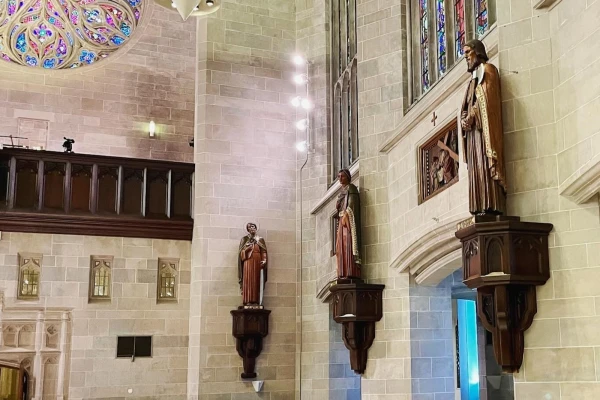
The name “Cathedral of the Arts,” Mech explained, is a reminder that the proof of God is beauty — a principle that guides each of the new initiatives he and his team have undertaken on the cathedral’s campus.
The latest project, the installation of the seven-and-a-half-foot-tall statues and relics encircling the cathedral’s interior worship space, is the crowning jewel of those efforts, transforming the cathedral into a permanent pilgrimage site, guided by the men who knew Christ most intimately during his time on earth.
Complete with first-class relics, the new installation is among the first of its kind in North America bringing together all 12 of Christ’s apostles for veneration, and the only exhibit in the world with the relics accessible in this way.
The 14 statues — including two eight-foot angels — each were carved from a single tree trunk in St. Ulrich Groeden, in modern-day Italy, in 1927. The statues were rescued from St. Benedict Church in Highland Park, which closed in 2014. After undergoing extensive restoration, the statues were installed in the cathedral’s nave in December.
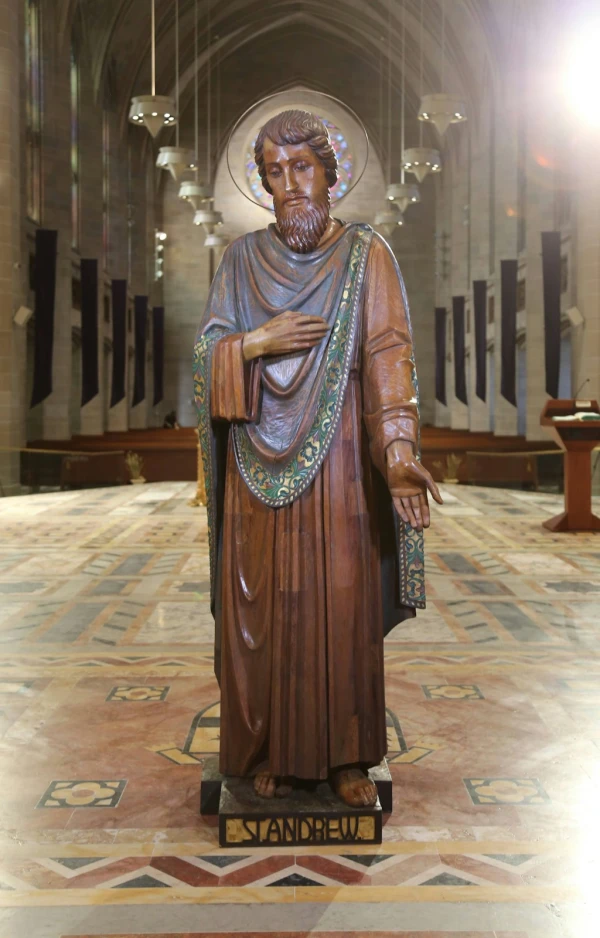
The statues include two angels, 10 of the original 12 apostles, St. Paul, and St. Matthias, the apostle who replaced Judas. Mech discovered that he had relics corresponding to the 12 saints, part of a collection of nearly 200 relics owned by the cathedral, all of which he hopes to be able to one day put on display.
The relics and the signage were installed beneath each statue beginning on Jan. 8, in time for the dedication and blessing of the new reliquary pilgrimage on Feb. 8.
“I am so excited about the transformation that is happening,” Mech said. “When you come in, there will be three main signs that tell you how to go on a pilgrimage, what the goal of a pilgrimage is, and how to interact with these relics. [Pilgrims] are going to walk away transformed, different, and they are going to enter through prayer.”
“Journey with the Saints” is much more than a museum of Church history, Mech said, but a rare opportunity to invoke the help of Catholicism’s greatest saints.
“It’s not just about looking at a pretty statue and touching some bones. [Pilgrims] are going to have a purpose when they walk away,” Mech said. “People can decide what they want intercession for, what they are hoping for when they pray to a particular saint, and when they walk away, they’ll keep praying for that.”
(Story continues below)
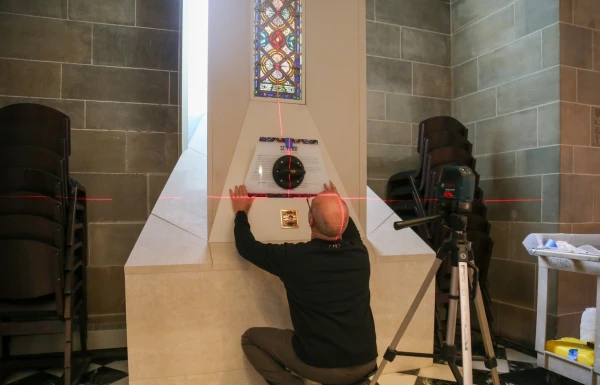
Mech said those whose prayers have been answered through the intercession of the saints will be invited to return to the cathedral and contribute a tile to a mosaic art piece that will be installed to show how God is answering prayers through the project.
While the saints and relics are the culmination of a long-sought project, it’s all part of a greater vision for Detroit’s cathedral, Mech said.
Another piece of the puzzle will be dedicated on May 12, when Archbishop Vigneron will unveil a new outdoor grotto at the cathedral in honor of the Blessed Virgin Mary.
During the height of the coronavirus pandemic in 2020, as the archbishop emotionally addressed the faithful during a livestreamed Mass from the cathedral, he entrusted the archdiocese to the protection of Our Lady of Lourdes and pledged to build the grotto “as a perpetual reminder” of her care and in memory of the lives lost to COVID-19.
Under the guidance of the archbishop, the Cathedral of the Most Blessed Sacrament finished a majority of the work on the grotto this fall, including statues of St. Bernadette Soubirous and Our Lady, whose face will reflect the one St. Bernadette saw in Lourdes, France, in 1858.
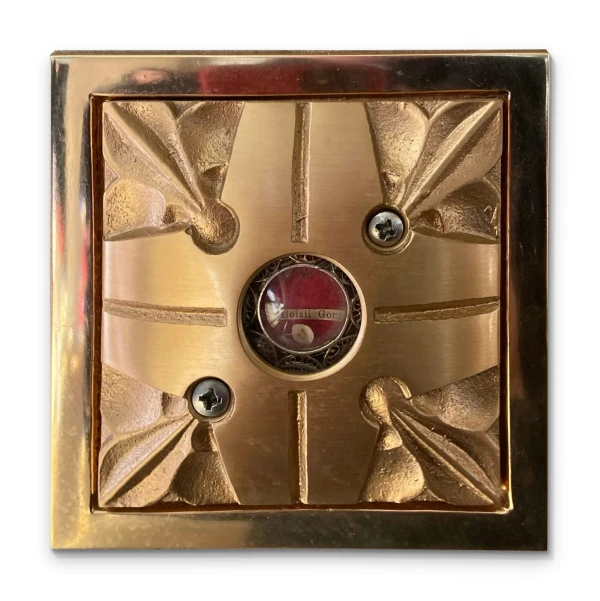
“People are already presently coming to pray [at] the grotto with the Blessed Mother,” Mech said. “We put some beautiful landscaping in this fall so people would feel welcomed, and in fact, we have used the site in a couple of ways for prayer services already.”
The grotto will also connect seamlessly with a garden walk that is being created around the cathedral’s plaza lawn, which will include art, benches, solar charging stations, a dog park, a bird sanctuary and pollination habitat.
Working alongside the U.S. Fish and Wildlife Service, the cathedral’s co-director of family ministries, Christine Broses, is spearheading the transformation of two previously empty lots on the corner of Trowbridge and John R Streets into green space for wildlife to thrive.
“We learned that the city of Detroit is a north, south, east, and west crossing for bird migration," Broses said. “So a lot of birds fly over the city of Detroit, but they don’t have anywhere to stop and rest because there isn’t a lot of green space. Creating green space is really important for the city and for wildlife in general, and research shows hearing birds and having green space in neighborhoods helps improve people’s mental health.”
Last spring, Broses oversaw the planting of native flowers in the area, and the next step is to let the space grow wild, which will inevitably attract birds and bees over the coming years. Broses said the final step will be to add educational plaques and pathways to make the spot accessible to schools and families.
Mech wants the garden spaces and pathways to be welcoming and intends to build benches — something the neighborhood is currently lacking.
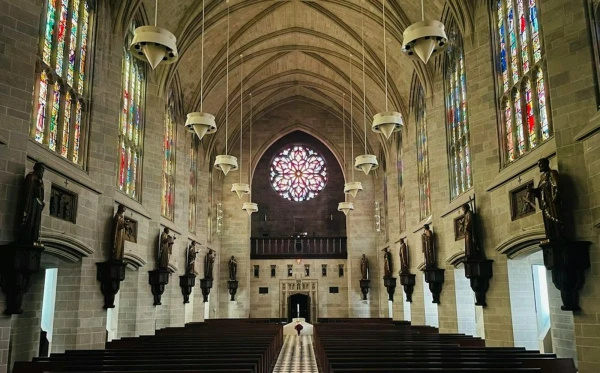
“We did a study of our neighborhood and found there is not a single park bench in any of the parks in our area,” Mech said. “We want to have park benches so people can come and rest and enjoy themselves. This will be a place where community can be built, and people will realize that the cathedral is not a fortress; we are actually unleashing the Gospel.”
And there is more.
In June, construction began on the Cathedral Arts Apartments, which will include four stories and 53 two-bedroom housing units for low-income Detroiters. The $19.7 million project is the joint effort of the Archdiocese of Detroit; MHT Housing, Inc.; and the city of Detroit and will include a community space and workforce training center.
The next big construction project will be to convert the cathedral’s dormant gymnasium into a community center, Mech said — he hopes to host beehives on the roof to harvest honey that can be sold to raise money for the community.
At the end of the day, the vision of a “Cathedral of the Arts” — like the cathedrals of old — is about listening to the Holy Spirit and making a difference from the very small to the large scale, so that everyone who steps onto the property is transformed, Mech said.
“When we get people onto the campus, they start to see what we are doing, and they get involved,” he said. “Then, the Holy Spirit does the rest and helps them to get to know Our Lord in new and wonderful ways.”






